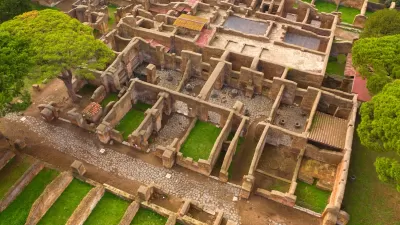Mass timber is called the first new way to construct tall buildings in 100 years.
"New structural systems come along rarely, and when they do, they usually wind up transforming cities," writes Justin Davidson.
The potential scale of such technological innovations is why planners should take notice of the advancements in wood construction. After millennia of two types of wood construction, architects have recently added a third technique: "sandwiching layers of wood and adhesive, yields cross-laminated timber (CLT), a kind of super-plywood that comes in immense slabs as long as a bowling lane and as thick as 12 inches."
"When steel replaced iron at the end of the 19th century, the path from the ten-story Home Insurance Building in Chicago to the Empire State Building took less than 50 years. Today, mass timber (the umbrella term for CLT and glulam) could have a similarly radical impact, because it gives architects and builders a chance to think in fresh ways," writes Davidson.
FULL STORY: Imagining a Wooden Skyline

Study: Maui’s Plan to Convert Vacation Rentals to Long-Term Housing Could Cause Nearly $1 Billion Economic Loss
The plan would reduce visitor accommodation by 25,% resulting in 1,900 jobs lost.

North Texas Transit Leaders Tout Benefits of TOD for Growing Region
At a summit focused on transit-oriented development, policymakers discussed how North Texas’ expanded light rail system can serve as a tool for economic growth.

Why Should We Subsidize Public Transportation?
Many public transit agencies face financial stress due to rising costs, declining fare revenue, and declining subsidies. Transit advocates must provide a strong business case for increasing public transit funding.

How to Make US Trains Faster
Changes to boarding platforms and a switch to electric trains could improve U.S. passenger rail service without the added cost of high-speed rail.

Columbia’s Revitalized ‘Loop’ Is a Hub for Local Entrepreneurs
A focus on small businesses is helping a commercial corridor in Columbia, Missouri thrive.

Invasive Insect Threatens Minnesota’s Ash Forests
The Emerald Ash Borer is a rapidly spreading invasive pest threatening Minnesota’s ash trees, and homeowners are encouraged to plant diverse replacement species, avoid moving ash firewood, and monitor for signs of infestation.
Urban Design for Planners 1: Software Tools
This six-course series explores essential urban design concepts using open source software and equips planners with the tools they need to participate fully in the urban design process.
Planning for Universal Design
Learn the tools for implementing Universal Design in planning regulations.
City of Santa Clarita
Ascent Environmental
Institute for Housing and Urban Development Studies (IHS)
City of Grandview
Harvard GSD Executive Education
Toledo-Lucas County Plan Commissions
Salt Lake City
NYU Wagner Graduate School of Public Service





























